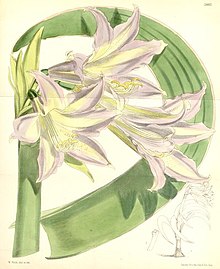en
names in breadcrumbs


Worsleya is a genus of Brazilian plants in the Amaryllis family, cultivated as an ornamental because of its showy flowers. There is only one known species, Worsleya procera, native to eastern Brazil.[6][7][8] It is endemic to a mesa called "Mount Cuca" 30 miles (52 km) north of Rio de Janeiro. Here the sickle-shaped leaves curve northward. When grown in the northern hemisphere, the leaves curve southward.[9] It is one of the largest (around 1.5 meters high) and rarest members of the subfamily Amaryllidoideae (family Amaryllidaceae).

This species is also known as the Empress of Brazil because of its origin in South America and in reference to the wife of Emperor Dom Pedro. It grows in very extreme and moist environments, and is commonly found near waterfalls in rich soil situated on granite rocks (which is why it is sometimes considered to be a lithophyte) and sunny places. However, it can be difficult to cultivate. It has plenty of needs, though it can exhibit great hardiness. It also has many ornamental traits.
The plant has a large bulb that produces a high stem with green recurved leaves. Worsleya produces spectacular and beautiful blooms. They are large, lilac to blue, with small freckles on them. The seeds are black and semicircular, and (when cultivated) are usually sown in pumice or sometimes Sphagnum, although with Sphagnum the threat of decay is higher.[11][12][13]
It is critically endangered,[1] and it is included in the Brazilian official list of endangered species.[14]
It is named after Arthington Worsley (1861-1943).[15]
The diploid chromosome count is 2n = 42 unlike its sister group Griffinia with 2n = 20.[16]
Worsleya is a genus of Brazilian plants in the Amaryllis family, cultivated as an ornamental because of its showy flowers. There is only one known species, Worsleya procera, native to eastern Brazil. It is endemic to a mesa called "Mount Cuca" 30 miles (52 km) north of Rio de Janeiro. Here the sickle-shaped leaves curve northward. When grown in the northern hemisphere, the leaves curve southward. It is one of the largest (around 1.5 meters high) and rarest members of the subfamily Amaryllidoideae (family Amaryllidaceae).
 Botanical illustration of Worsleya procera
Botanical illustration of Worsleya procera This species is also known as the Empress of Brazil because of its origin in South America and in reference to the wife of Emperor Dom Pedro. It grows in very extreme and moist environments, and is commonly found near waterfalls in rich soil situated on granite rocks (which is why it is sometimes considered to be a lithophyte) and sunny places. However, it can be difficult to cultivate. It has plenty of needs, though it can exhibit great hardiness. It also has many ornamental traits.
Worsleya es un género monotípico de plantas herbáceas, perennes y bulbosas perteneciente a la familia Amaryllidaceae. El género comprende una sola especie originaria del este de Brasil: Worsleya procera (Lem.) Traub.[2]
Worsleya procera es una de las plantas bulbosas más solicitadas y más raras del mundo. Es nativa de Brasil. En su hábitat natural estas plantas crecen en los acantilados escarpados de granito en suelos con buen drenaje, totalmente expuestas al viento, la lluvia y el sol, constantemente sometidas a la niebla de las cascadas. Produce grandes racimos de hermosas flores de color azul-lila, salpicado de malva por dentro, florece a mediados de verano con tallos de hasta 1,5 metros de altura.[3]
Worsleya procera fue descrita por (Lem.) Traub y publicado en Herbertia 10: 89, en el año 1944.[4][5]
Worsleya es un género monotípico de plantas herbáceas, perennes y bulbosas perteneciente a la familia Amaryllidaceae. El género comprende una sola especie originaria del este de Brasil: Worsleya procera (Lem.) Traub.
Genre monotypique rare endémique du Brésil. L'espèce a été placée tantôt dans ce genre, tantôt dans les genres Amaryllis ou Hippeastrum, tantôt nommée Worsleya rayneri comme ici, tantôt Worsleya procera ou Worsleya gigantea.
Genre monotypique rare endémique du Brésil. L'espèce a été placée tantôt dans ce genre, tantôt dans les genres Amaryllis ou Hippeastrum, tantôt nommée Worsleya rayneri comme ici, tantôt Worsleya procera ou Worsleya gigantea.
Plavi amarilis (vorsleja, lat. Worsleya), monotipski rod lukovičaste trajnice iz porodice zvanikovki, smješten u tribus Griffineae, dio potporodice Amaryllidoideae. Jedina vrsta je W. procera iz istočnog Brazila[1].
Plavi amarilis (vorsleja, lat. Worsleya), monotipski rod lukovičaste trajnice iz porodice zvanikovki, smješten u tribus Griffineae, dio potporodice Amaryllidoideae. Jedina vrsta je W. procera iz istočnog Brazila.
L’imperatrice del Brasile (Worsleya procera (Lem.) Traub) è una pianta bulbosa appartenente alla famiglia delle Amaryllidaceae. È l'unica specie nota del genere Worsleya (W.Watson ex Traub).[1]
La pianta ha un grande bulbo che produce uno stelo alto con foglie ricurve verdi. I fiori sono grandi, dal lilla al blu, con piccole lentiggini all'interno; il frutto è una capsula da cui a maturazione fuoriescono i semi, neri e semicircolari.[2]
La specie cresce in ambienti molto estremi e umidi, e si trova comunemente vicino a cascate in terreni ricchi situati su rocce di granito (che è il motivo per cui a volte è considerato una litofita) e luoghi soleggiati. ed è endemica del Brasile orientale.[3]
L’imperatrice del Brasile (Worsleya procera (Lem.) Traub) è una pianta bulbosa appartenente alla famiglia delle Amaryllidaceae. È l'unica specie nota del genere Worsleya (W.Watson ex Traub).